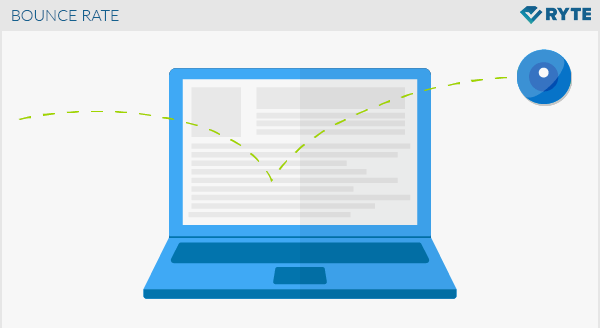Bounce Rate
The bounce rate is the ratio of website visitors who view more than one page to those who view only one page. The length of time spent on the website can also be used to specify the bounce rate. The bounce rate is an important KPI in online marketing.
Bounce rate as part of web analytics
For webmasters and SEOs, the bounce rate can be a good indicator of the success of a page of a website. In SEA, the bounce rate can also show the efficiency of display or text ad campaigns.
Many different types of conclusions can be drawn from analyzing the bounce rate. For exmaple, in online marketing or SEO, it may also be necessary to adapt the landing page to make sure that visitors find exactly what they're looking for, to avoid them leaving the website without looking at further subpages. In search engine marketing, the source being referred to, i.e. text or image ads, might need to be optimized so that the search matches the landing page. However,
Interpretation of values
Bounce rates vary from industry to industry and from topic to topic. There is no general rule as to exactly when the bounce rate should be analyzed in more detail to find reasons for an excessive bounces. The quality of the bounce rate can be best judged using benchmarks from a similar industry.
The differentiation between new users and regular users would also be important when analyzing the bounce rate, usually because the bounce rate would be higher for new visitors. Users who come to your visit by clicking on an ad might bounce faster because they are new and don't yet know your website or brand.
Another possible way of specifying the bounce rate is to convey the length of time the reader spends on a page. The bounce rate for a website may be high, but the content may still all-inclusively be consumed by the users.
Possible reasons for a high bounce rate
- A single page without sub-pages: A page without a sub-page will automatically have a 100% bounce rate, because the web analytics tool will not register any further page views. Reloads of the page are not taken into account. Analyzing the dwell time however could be sufficient for finding out whether the users found what they were looking for. If necessary, tracking can be implemented for a more detailed overview of visitor behavior, for example mouse tracking or event tracking.
- Faulty integration of tracking codes: Every web analytics tool works with a tracking code that must be installed in the source code of the page. If the code was implemented incorrectly, the bounce rate might be measured as being higher than it actually is.
- Poor page design: If users don't find what they are looking for, they will leave the page, resulting in a high bounce rate. Redesigning the page making it easier for visitors to navigate your website will improve the bounce rate, and improve the user experience.
- Unattractive content: If you only optimize your website content in order to rank well, you’ll end up with a high bounce rate, because if visitors don’t find enough information on the subject they searched for, they will immediately exit the page.
Bounce Rate vs. exit rate
The bounce rate is sometimes confused with the exit rate. However, these are two fundamentally different parameters. The bounce rate measures the percentage of visitors of a landing page who leave the page without viewing any other pages. When measuring the exit rate, the entire session is considered. The exit rate of a page indicates how often this page was the last page a user saw on your website.
Return to SERP rate
In connection with the bounce rate, the Return-to-SERP-Rate is also often mentioned. This is the number of visitors in relation to the page visitors which return to the search results after visiting the page. This figure plays an important role for the search engines because it shows the search engines whether the user has found the content they were looking for on the landing page.
Theoretically, there are three interpretation possibilities:
- The user has not found the desired page and searches further for other websites
- The user has not found what they desire on the landing page and specifies the search.
- After returning to the SERPs, the user searches for something else.
In all three cases, a negative signal will be given to the search engine. To what extent the Return-to-SERP-Rate influences the ranking of an individual page in relation to a specific search query is, however, not yet known.
Importance for SEO
In search engine optimization and web analytics, bounce rate must be observed in order to identify what needs to be optimized. When a visitor clicks on an index # organic search result and immediately bounces back to the search engine, this may be a signal to the search engine that the quality of the page does not meet the user’s expectations. It is not known whether Google incorporates these metrics directly in the evaluation of a page. However, Google recommends observing this statistic to identify poorly converted content.
The bounce rate gives important clues to SEOs as to whether design or content must be optimized in order to prompt visitors to spend more time on the site (length of stay). The bounce rate can also be an effective indicator for the success of SEA campaigns.
Web Links

